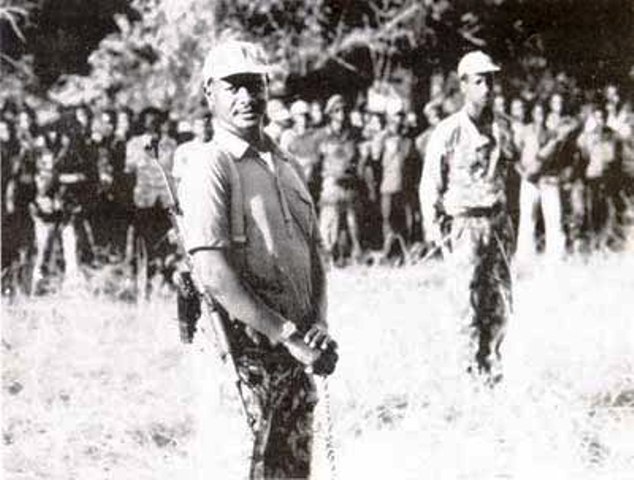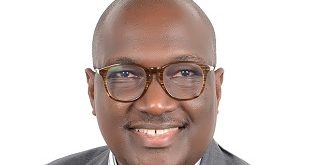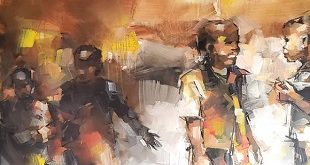
Special 1000: Why they matter more than the 195km trekked
Kampala, Uganda | INDEPENDENT TEAM | President Yoweri Museveni’s recent six-day trek of remembrance of the major battles of his five-year war to capture power through the so-called ‘Luweero Triangle’ was packed with recollection, endurance, and emotion.
From Jan.03 to Jan.09, Museveni did the trek through seven districts; from Galamba in Wakiso District through Nakaseke, Mityana, Kiboga, Kasanda, Mubende and finally to Birembo in Kakumiro District.
Major physical features and landmarks remain but the area has changed and the trek was more symbolic than an accurate retracing of the footsteps Museveni and his rag-tag army of hungry, harried, and rain-soaked rebels trudged 35 years ago.
In Galamba which was a thick forested area just 30km from Kampala, only nearby River Mayanja and Semuto Road remain as major markers. The rest of the landscape has new trading centres, roads, hospitals, and schools; including St. Edward’s College where the march started.
Galamba is significant because it is from here that Museveni tactically split his 1,500 strong force into two in a ruse that confused the enemy, enabled the fighters to finally successfully attack and overrun Kabamba Barracks and grab the biggest haul of weapons – 650 rifles, mortars, machine guns, ammunitions, and other items. It was the third attempt as Kabamba I &II had failed.
When Museveni’s rebels moved here 35-years ago, across River Mayanja, on their southern 200km trek to Kabamba in Mubende, it was in zig-zag fashion to ward-off trackers, through bush, mostly at night. Museveni’s younger brother, Caleb Akandwanaho aka Salim Saleh led the main force that attacked Kabamba after a seven-day trek.
He was just 25-years old but already an accomplished commander, having received military training in Mozambique when he was just 16 years in 1976. He later participated in the Front for National Salvation (FRONASA) battles that together with the main force of Uganda National Liberation Army (UNLA), ended in the 1979 Liberation war that kicked out President Idi Amin.
Saleh’s force arrived at Kabamba without being discovered by the enemy and therefore avoiding attack. He led 700 men, including so-called ‘commandos’ – the unarmed fighters whose job was to carry loot.
It was a different story for Museveni who led the rest as a decoy, deliberately exposing themselves to the enemy and coming under enemy artillery fire from the APCs and helicopters of government forces that had supporting military advisors from the armies of Tanzania and North Korea.
Birembo, which is about 180km from Galamba on a straight Kampala-Mityana-Mubende-Kakumiro highway, was significant because it is here that Museveni linked up with Saleh after the raid on Kabamba. For the rendezvous, Saleh had to lead his men, under intense enemy fire, from Kabamba.
Birembo also marked a turning point in the war as the enemy army became demoralized and divided and led to the second military over-throw of Obote, just seven months later, on July 27, 1985.

But Museveni’s recent trek, code-named “Africa Kwetu” to invoke a Pan-Africa spirit in a largely local event, has been marred by controversies; including questions about its purpose, organisation and criteria for selection of participants, and why, even after 34 years in power, the area which was the base of the war remains the poorest part of central Uganda.
The area called Nakaseke District today, which covers most of what was Luweero District in the 1980s is among the poorest areas of Uganda, with income figures similar to the most impoverished areas of Abim, Kaberamaido, Katakwi and others in northeastern Uganda. These areas have GDP per capita between US$112 (Nakaseke) and US$104 (Kaberamaido), according to a 2017 study by the United States Agency for International Development (USAID).
Residents of Nakaseke were not shy to demand answers from Museveni whenever he made a stop. They said the President’s march through their villages was perfect chance to directly put their grievances to him. At Bukatira in Nakaseke South Constituency they bluntly told him they had not received any appreciation for supporting the war of liberation.
“You promised to give us a secondary school in Kilema Village but we have never seen it since the war ended. It has never been built,” said Ismail Kasozi, the Semuto Sub-county chairperson, when he got a chance to address the President directly, “Mr. President I request that you honour your promises.”
The president, as he sometimes does, attempted to blame opposition politicians.
“Nakaseke (South) made a mistake and sent in a young man called Lutamaguzi. You sent this useless young man (to Parliament), Lutamaguzi. Akavubuka tekalinna makulu (that young man is useless). So that is your own mistake,” he told the villagers. But the villagers remained adamant.
Museveni cannot blame Lutamaguzi for his failure to keep his promises, some said. Lutamaguzi has been in parliament for only three years but Museveni has been in power for 34 years and done nothing for us.
Such confrontations, it appears, must have been anticipated. And that could explain why, from Galamba, Museveni’s trek only symbolically entered Nakaseke before quickly darting westwards into Mityana district.
That is how Museveni ended up largely trekking outside of the historical Luweero Triangle; the area that starts with Kampala as the apex of the triangle, and encloses the area between the Kampala-Hoima road and Kampala-Nakasongola-Masindi road northwards to River Kafu. In the 1980s, the main districts here were Luweero and Mpigi. Present day Wakiso and Kiboga were in Mpigi and Nakasongola and Nakaseke were in Luweero.
During the actual march to Birembo in 1984, according to Gen. Pecos Kutesa, in his book titled ‘Uganda’s Revolution 1979-1986: How I saw it,’ Museveni’s flank of the campaign in fact went deeper into present day Nakaseke; then into Bukomero and Kyamusisi in present day Kiboga, through Mubende to Kakumiro (which until 2018 was part of Kibaale District).
But criticism and grumbling by veterans who feel cheated has not stopped the achievement of walking 195km on some of the roughest terrains imaginable earning the 76-year old President praise.
 The Independent Uganda: You get the Truth we Pay the Price
The Independent Uganda: You get the Truth we Pay the Price



